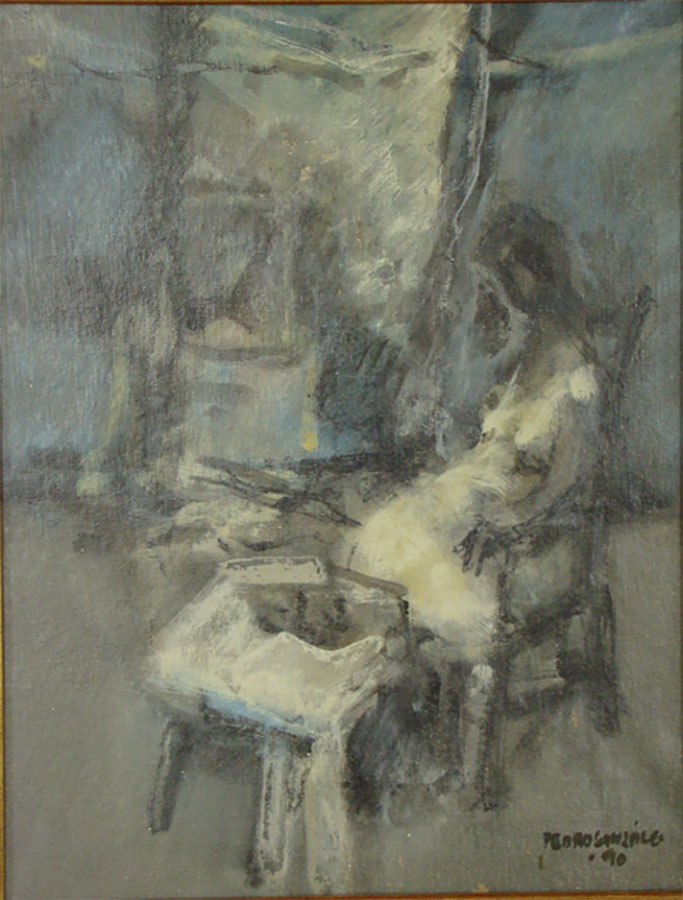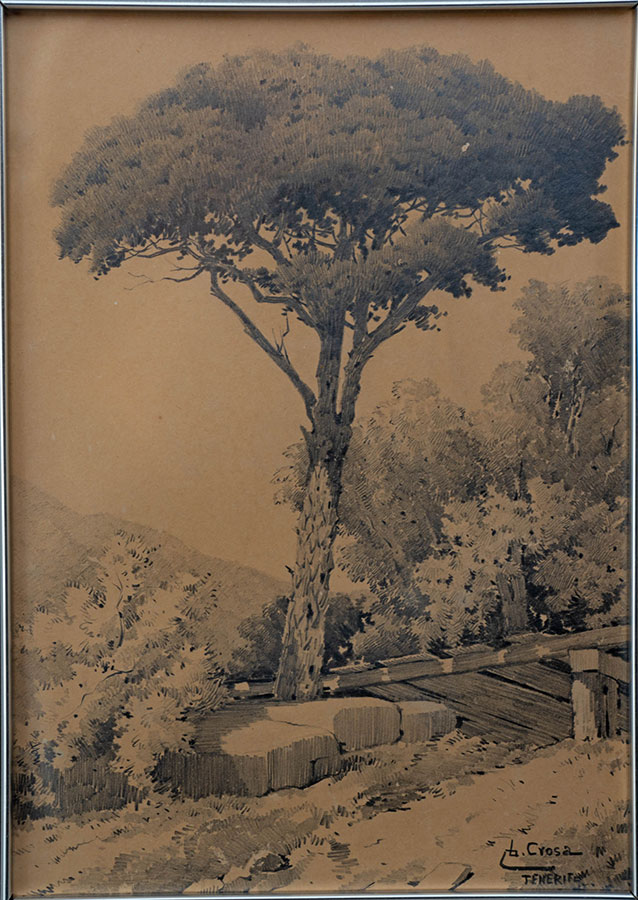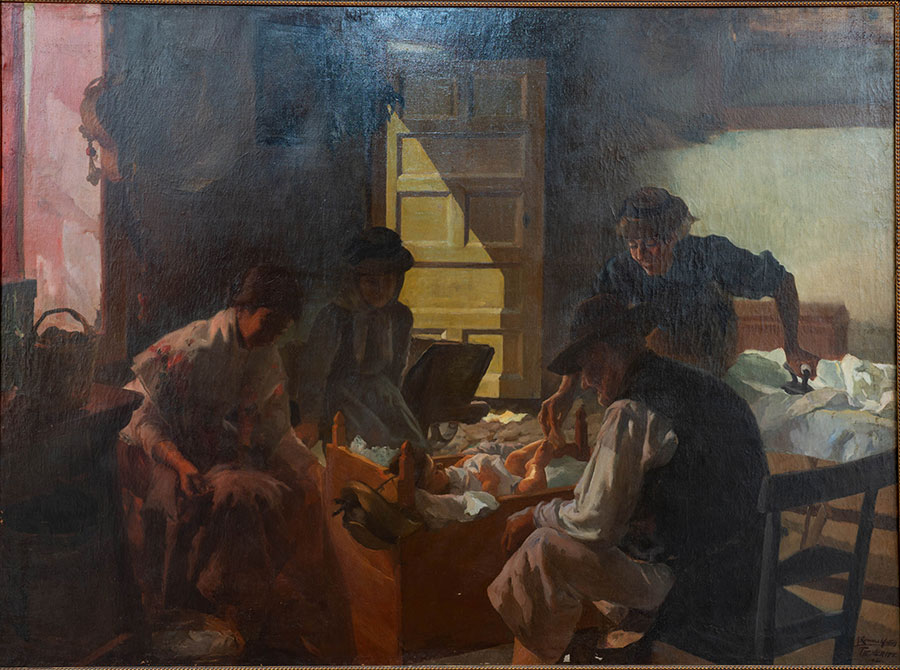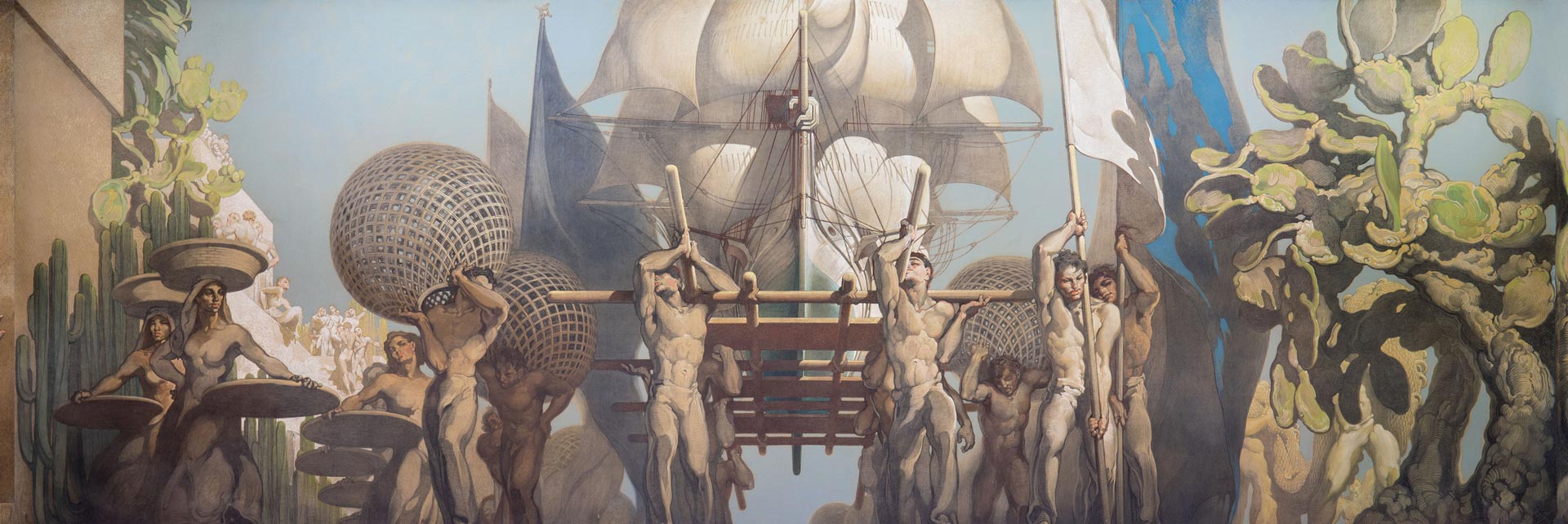
- Type of work: Easel painting
- Technique: Mixed media on canvas
- Approximate dimensions: 46 x 38,5 cm
- Theme: Intimate composition
- Title: Remanso
- Author: Pedro González (*1927)
- Chronology or Year: 1990
- Historical-artistic analysis:
Style: Neofiguration
Description: Inside a room appears in a diagonal position a female figure sitting on a chair in front of a small low table, the only furniture in the dreary room. Both the objects and the human figure are presented as ghostly apparitions that even levitate, dissolved in the light, surrounded by silence, in a chromatic range of bluish grays and ochers.
Date received: After 1990
Observations: Between 1989 and 1990 P. Gonzalez makes studies of interiors as scenes born of memory or nostalgia, full of silence. In 1990 he made an exhibition at the Caja General de Ahorros de Canarias in Santa Cruz de Tenerife of interiors with elderly people, along with still lifes and female figures imprisoned between the bars of the bed. In all these paintings the human figure appears as a dematerialized apparition, dissolved in light, enigmatic.
About the author: Born in 1927, Pedro González began his contact with the world of art in the study of Spanish baroque painting, especially Velásquez, during his visits to the Prado Museum during his first stay in Madrid as a student at the School of Engineers between 1946-48. On his return to Tenerife to study Chemical Sciences at the University of La Laguna, he also enrolled at the Escuela Superior de Bellas Arte de Santa Cruz, then dependent on the Escuela Superior de Santa Isabel de Hungría in Seville, where he began to learn watercolor under the teaching of Mariano Cossío in terms of color relations and Pedro de Guezala in drawing technique, with the influence of the Catalan Baudilio Mró Mainou also being fundamental, with his landscape synthesis of broad and loose brushstrokes. This initial production was exhibited in 1953, in the Provenza room in Santa Cruz. Graduated in Chemical Sciences in 1954, he went to Venezuela, hired by the Ministry of Education of that country as a mathematics teacher at the Lisandro Alvarado High School in Barquisimeto, also joining the faculty of the School of Plastic Arts of that city in 1955, year in which he showed the expressionist painting that emerged from his encounter with the tropics at the Society of Venezuelan Writers in Caracas, with great critical acclaim. His move to Caracas as a professor at the Polytechnic School in the university city allowed him to come into contact with the most outstanding Venezuelan painters and to get to know the international art scene through the art galleries and the exhibitions organized at the Museo de Bellas Artes de Caracas, a city that was then experiencing a period of intense cultural activity, contributing all this avant-garde environment to the overcoming of his figurative stage. However, the human figure was still present in the solo exhibition of 1957 held at the Casino of Tenerife and in the work presented at the Regional Exhibition of Painting and Sculpture of 1960, Women and houses , for which he won first prize. The exhibition of the monotype series presented the following year at the Museo Nacional de Bellas Arte in Caracas is the starting point of his first abstract work. With the Icerse series (1962-1965) he enters into abstract compositions, without figurative references, within informalism, since its structure is not based on geometry but on the constructive and volumetric value of the stain, whose density contrasts with its lightness. With this work he obtained the prize of honor in the Regional Exhibition of 1962, year in which he also made himself known in the Spanish Institute in Munich and in 1963 in the Sala Neblí in Madrid, city where from then on he exhibited periodically in different galleries (Sen, Ateneo, Rayuela, Estampa) with great critical acclaim. Since his return to Tenerife in 1961 Pedro Gonzalez plays a very important role in the revitalization of the cultural scene of the island with the founding of the group Nuestro Arte in 1963, a group that brings together the defenders of the avant-garde proposals and links with the ideas of Gaceta de Arte of the thirties, also assuming a theoretical commitment in the dissemination of abstract art through essays and articles in the press. This work of diffusion is also carried out through teaching as a professor of coloring at the School of Fine Arts of Santa Cruz de Tenerife from 1964, a center that together with the Municipal Museum of Fine Arts opened the doors to the groundbreaking position of Nuestro Arte, participating in all the exhibitions of this group between 1965 and 1970. From 1967 a dematerialized figuration appears in his painting that gives way to the Cosmoarte series, a title that alludes to the adventure of man in space, which he exhibited at the Municipal Museum of Santa Cruz and at the General Directorate of Fine Arts in Madrid in 1968, and since that year his work has been exhibited at the Spanish Museum of Contemporary Art. His participation in the politics of his city, first as an independent heading the PSOE list, then as mayor in two terms (1979 and 1983), does not interrupt his artistic production, organized in successive series (El Mar, El bosque, Coches, La patera, El hambre, etc.), in which he no longer dispenses with figures and objects, in a neo-figuration that produces disquiet, tension and mystery.), in which he no longer dispenses with figures and objects, in a neo-figuration that produces restlessness, tension and mystery, showing his work both in Canary institutions, and in Madrid, Bilbao, Seville, Montreal, New York, Washington or Caracas, awarded in 1988 with the Canary Islands Prize for Fine Arts and Interpretation. He is represented, among other collections, in the collections of the Museo Nacional Centro de Arte Reina Sofía, the Ateneo de Madrid Collection, and the Museo Nacional de Bellas Artes de Venezuela.
Bibliography:
Archive of the Casino de Tenerife.
Fernando CASTRO BORREGO: P. González. Viceconsejería de Cultura y Deportes Gobierno de Canarias, Santa Cruz de Tenerife, 2000.
Catalog of the exhibition Pedro González, held at the Instituto de Canarias Cabrera Pinto, La Laguna, from March 20 to May 10, 2009.
Valeriano WEYLER: The small history of a great casino (The one in Santa Cruz de Tenerife). Santa Cruz de Tenerife, 1964.
Agustín GUIMERÁ RAVINA, Alberto DARIAS PRÍNCIPE: El Casino de Tenerife 1840 – 1990, Santa Cruz de Tenerife, 1992.




